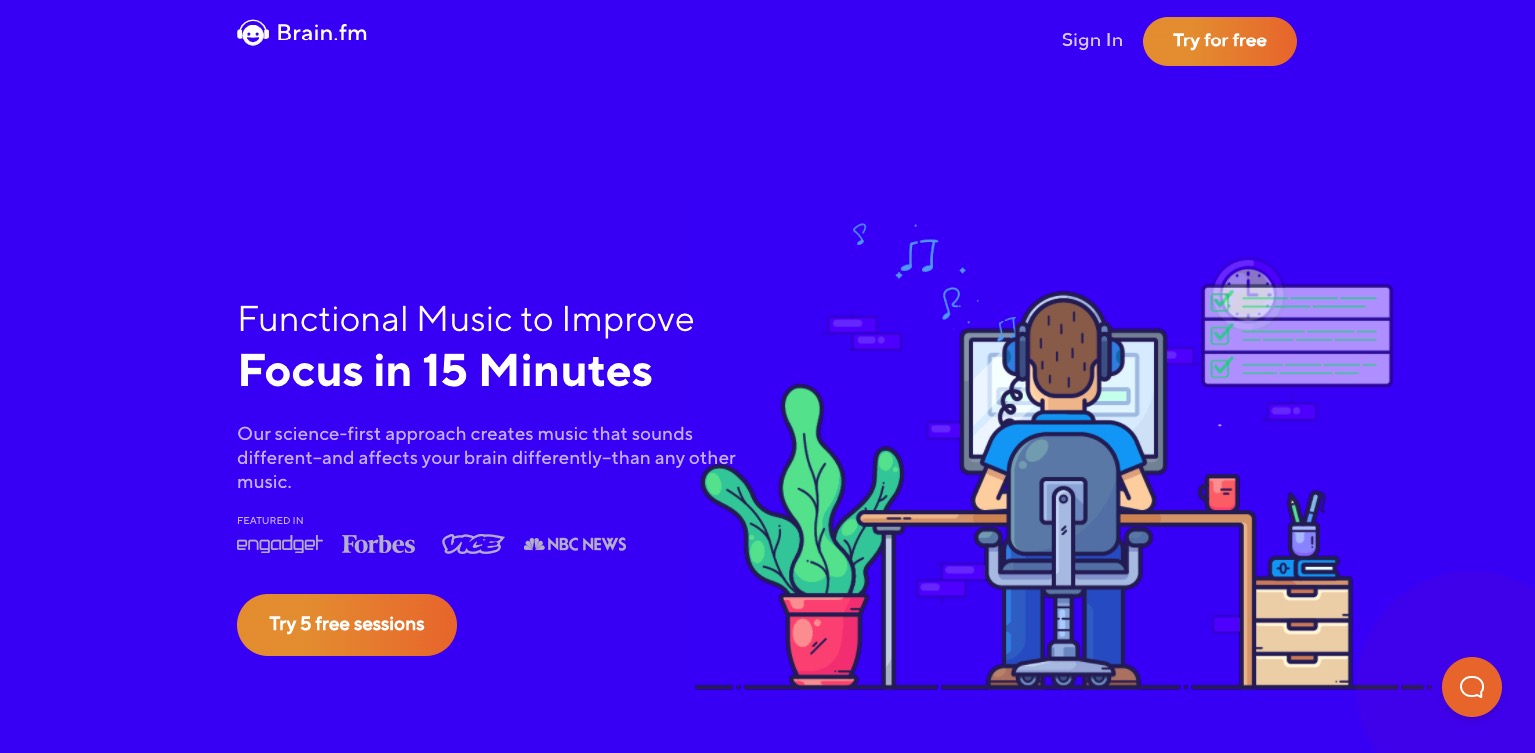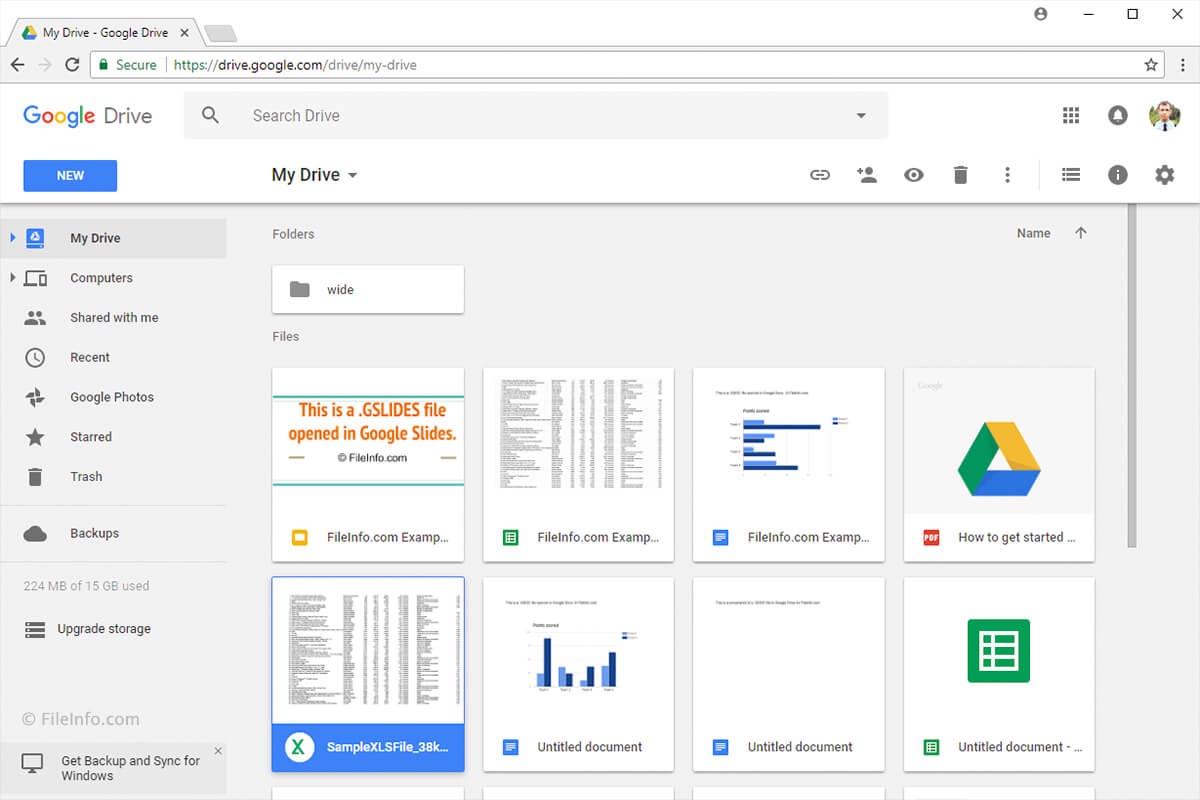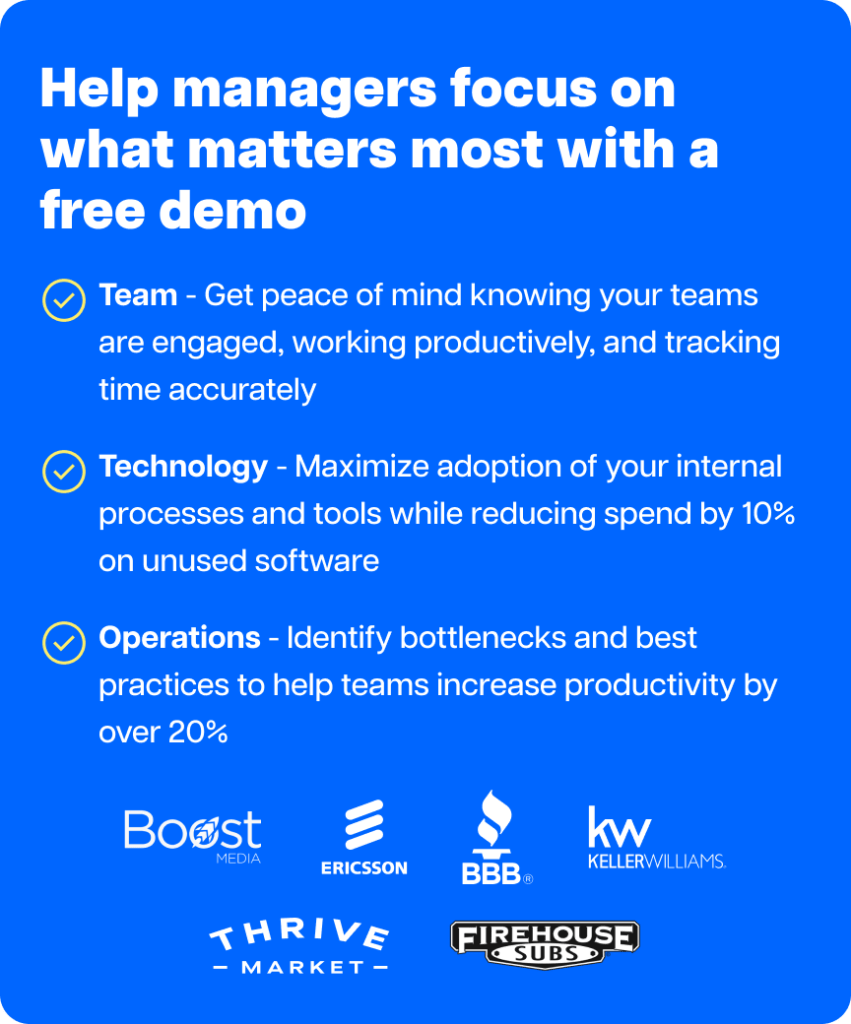Finding it hard to keep your remote employees productive?
You’re not alone.
Suddenly adapting to remote work during a pandemic can be challenging for anybody.
But don’t worry, once your team gets the hang of it, remote employee productivity isn’t hard to achieve.
To help you start off, this article covers 6 tips to help boost remote employee productivity during the ongoing COVID-19 pandemic. We’ll also highlight how remote employees can be more productive than their in-office counterparts!
This article contains:
(Click on a link below to jump to a specific section)
Why Remote Employees Are More Productive
6 Tips To Boost Remote Employee Productivity
- Designate A Separated Workspace
- Use Daily Goals And To-Do Lists
- Set A Schedule And Stick To It
- Minimize Distractions
- Take Frequent Breaks
- Use The Right Productivity Software
Let’s get started.
Why remote employees are more productive
Most remote employees can be more productive than on-site or in-office staff.
Surprised?
A Stanford study by Nicholas Bloom and Ctrip co-founder James Liang, found that not only are remote employees more productive but also take shorter breaks, less time off, and fewer sick days.
How?
Remote work can eliminate several of the disadvantages associated with working from an office environment. This allows remote employees to focus better and work more efficiently.
Here’s a closer look:
1. Time saved on commute
One of the biggest advantages of remote work is the lack of a daily commute.
On average, an American employee spends almost 30 minutes commuting to their office. That’s an hour spent on getting to and back from work every day!
A remote worker, on the other hand, can put this extra hour into productive activities every day.
Apart from time, remote workers also preserve the energy that would’ve been taken up by their daily commute. This allows them to easily focus and boost their productivity during their work hours as well.
2. Fewer distractions
This might seem counterintuitive at first.
After all, how can a house have fewer distractions than an office space?
Turns out, office environments aren’t the most efficient settings to focus and work.
Why?
Offices have plenty of distractions of their own!
These can include:
- Non-work related conversations amongst coworkers.
- Distracting sounds and noise.
- Errands around the office.
- Coffee and social breaks.
Meanwhile, working from the comfort of your own house helps eliminate such distractions.
Although WFH (work from home) has its own distractions, you can control or deal with the sources of the distractions, which makes it much easier to minimize them.
This way, you can work in a quiet and peaceful environment without getting sidetracked — maximizing your concentration and productivity.
3. Flexible schedules
The flexibility of remote positions is another attractive benefit for several telecommuters.
Traditional offices have to follow rigid work hours and schedules to be able to function efficiently. Every employee needs to conform to these times in order to maintain the functionality of the entire office.
However, this doesn’t have to be the case while telecommuting.
Depending upon the role, many remote workers have flexible schedules for work.
This means that they can work at their peak productivity hours, allowing them to deliver better results for the same number of work hours while increasing job satisfaction as well.
But if everyone works on their own schedule, how will my team collaborate?
If you’re worried about flexible schedules affecting remote team collaboration, you can always set a few common availability hours.
During these select hours, everyone on the team must be online and available on remote communication tools like Slack, Microsoft Teams, or Zoom. This is when video conferencing/ video call meetings and real-time check-ins can take place.
6 tips to boost remote employee productivity
Remote work can be far more productive than traditional in-office arrangements, but only if done right. Luckily, a few simple steps can help streamline your transition into productive remote working easily.

Here are 6 tips that can boost remote employee productivity:
1. Designate a separate workspace
The first step to maintaining a healthy work-life balance when working remotely is to separate your workspace from the rest of your house.
Why?
Not only does this help you eliminate distractions, but it also helps you get into the right mindset to work in the first place.
For example, if you work remotely from your bed, it’s difficult to feel motivated to work. This is because your mind associates your bed with rest and relaxation, not focus and concentration.
Your designated workspace can be as simple as a particular desk, or as elaborate as your own customized study room.
Clear non-work related items from your workspace and limit professional activity to this space only. (You can also keep all your office stationery and tools here for easy access.)
If you live with housemates or family, your designated workspace can also act as an “at work” or “do not disturb” sign. Your presence at your home office lets people know that you’re at work. This helps further limit interruptions when you don’t live alone.
2. Use daily goals and to-do lists
Writing down your tasks and goals for the day is key to efficient time management.
While you probably have a rough idea of your work for the day, creating actionable tasks lets you budget your time and boost productivity.
At the beginning of each workday, set aside a few minutes to plan your work.
Break large tasks and projects into smaller, actionable goals.
For example, if you need to write a blog post today, you could break this down into smaller tasks such as:
- Researching and gathering sources.
- Creating a comprehensive outline.
- Writing the first draft.
- Editing and polishing the draft.
- Uploading it.
Arrange these goals into to-do lists according to your work hours and schedule.
A to-do list ensures that you don’t forget any of the tasks you’re supposed to complete. It makes it easier for you to organize your work according to priority, urgency, or the length of the tasks.
You can write out your to-do lists with pen and paper, or by using a handy project management tool.
Other benefits of setting up goals and to-do lists include:
- Breaking tasks into smaller steps makes them less daunting and more approachable.
- Subtasks make it easier to calculate time estimates and budgets.
- Actionable goals streamline project management activities that lead to increased remote team communication and productivity.
3. Set a schedule and stick to it
Goals and to-do lists won’t be effective unless you have a schedule to go with them.
Remember, remote employee productivity requires powerful time management and self-discipline skills. And the best way to enhance these skills is by setting up a schedule.
Depending on the flexibility and work hours required by your company, create a schedule that can best align with your peak productivity hours.
Normally, these would be when your creativity and focus are highest.
However, due to the restrictions of the Coronavirus pandemic, you may have to schedule your work according to a larger variety of factors, like:
- When you’re least likely to be distracted by housemates.
- Chores and additional responsibilities during the quarantine.
- Your children’s needs or sleep schedules.
Apart from designating work hours, your schedule should include breaks for relaxation as well as physical activity/exercise. This helps you maintain your health and productivity levels — preventing you from burning out easily.
Once you’ve created your daily schedule, follow it for a few days to see if it needs any changes to improve productivity or teamwork. Then, integrate these changes into an updated schedule and make sure you stick to it.
There are a lot of positive changes that you can make by following these work from home tips that can help you increase your productivity.
4. Minimize distractions
While avoiding distractions entirely is impossible, minimizing them is one of the best ways to quickly boost your productivity.
But the biggest problem?
Distractions are everywhere.
From your surroundings and your phone to your computer itself, you need to take several measures just to keep your focus undivided.
But here’s the good news: most of these measures are extremely simple and effective.
Here are a few things you can do to eliminate distractions:
From your workspace
- Remove objects that aren’t work-related.
- Create a small “Do Not Disturb” sign if you don’t live alone.
- Use noise-canceling headphones to drown out surrounding noise.
On your devices
- Turn off notifications that aren’t work-related.
- Keep your phone on silent/switched off and out of your reach.
- Stay away from time drains like social media.
While these are a few general tips that can help remote employees universally, you can further boost productivity by identifying your specific needs.
Ask yourself questions like:
- Which distractions are most likely to divide your attention?
- Are you prone to multitasking?
- Does music, ambient noise, and/or meditation help improve your focus?
Adapt your work process accordingly for an instant productivity boost.
5. Take frequent breaks
To really maximize your productivity, you need to know when to stop working!
Working several hours at a stretch impacts your focus and can easily lead to burnout. Instead, try to take frequent breaks to take your mind off of work.
How often should you take a break and for how long?
While this depends upon your personal work process and attention span, try to take at least one break every 1–1.5 hours.
Many people swear by the Pomodoro Technique, which involves 25-minute sprints (when you focus on your work) with 5-minute breaks in between. After 4 sprints, take a longer break of 15-30 minutes before returning to work.
What should you do during your break?
Anything but work.
Do something that helps you release stress and freshen yourself up, like:
- Stretching and taking a short stroll: sitting in one place for long hours can easily get tiring.
- Drinking water: remember to stay hydrated!
- Munching on a snack: helps maintain your energy levels.
6. Use the right productivity software
At the end of the day, all the above tips can help you get started with productive remote work.
But without the right productivity software, it can be challenging to continue with these practices effectively.
These tools will help you stay focused and monitor your productivity, giving that additional boost to maximize remote employee productivity.
Here are three tools that are must-haves for any remote employee:
A. Remote productivity software: Time Doctor
![]()
Time Doctor is a powerful employee productivity and time management tool used by major companies like Apple, Verizon, and PwC as well as SMBs such as Firehouse Subs. Its advanced features help you boost remote employee productivity and performance easily.
Here’s a quick look at some of its features that help maximize remote employee productivity:
1) Distraction management
Despite your best efforts, social media and other remote work distractions can be extremely tempting!
Luckily, Time Doctor helps keep distractions in check with its Distraction Management feature. It alerts an employee when they access any irrelevant website or app, which is usually enough to get them back on track.
2) Inactivity tracker
Time Doctor’s Inactivity Tracker helps ensure that employees are actively working. If there’s no keyboard/mouse activity for up to three minutes, it’ll automatically stop the timer and put you on a break. This ensures that employees don’t run the timer and binge-watch Netflix!
Note: To safeguard your privacy, Time Doctor does not track what keys you press or what you click on. It only checks if any keystroke or clicks take place or not.
3) Time tracking
With a simple but powerful Time Tracking feature, Time Doctor helps you time your work as well as your breaks accurately. This ensures that you don’t work too long in a single stretch, helping you stay productive throughout the day.
4) Detailed reporting features
Time Doctor features detailed reports that help analyze and track your work productivity.
Some of its key reports are:
- Time Use Report: Displays how long you worked on each task over a given period, such as a day, week, month, or a custom date range.
- Web And App Usage Report: Highlights which website and apps you spent time on, and for how long.
- Projects Report: Time spent by each team member on a project within a set time frame.
B. Focus boosting software: Brain.fm

Brain.fm is a focus app that uses functional music to help you focus while working or relax during your breaks. You can choose music from various genres according to what works best for you.
Available as an Android and iOS app, Brain.fm plays in the background and is sure to boost your productivity throughout the day.
C. File management software: Google Drive

Google Drive is Google’s popular cloud-based file storage and sharing. It helps you manage work documents, spreadsheets, and presentations remotely.
The best part?
Google Drive is compatible with various workplace tools, helping you manage and share files across the board. This way, you won’t have to search for that pesky file – everything’s always available at the click of a button.
Final thoughts
Staying productive can be difficult when you’re new to remote work.
But once you get the hang of it, remote employees can be just as (if not more) productive than full-time office workers!
Use the tips and tools above to give your remote team’s productivity a massive boost.
To get started, why not sign up for a powerful employee productivity tool like Time Doctor and skyrocket your team’s productivity today?

Liam Martin is a serial entrepreneur, co-founder of Time Doctor, Staff.com, and the Running Remote Conference, and author of the Wall Street Journal bestseller, “Running Remote.” He advocates for remote work and helps businesses optimize their remote teams.


